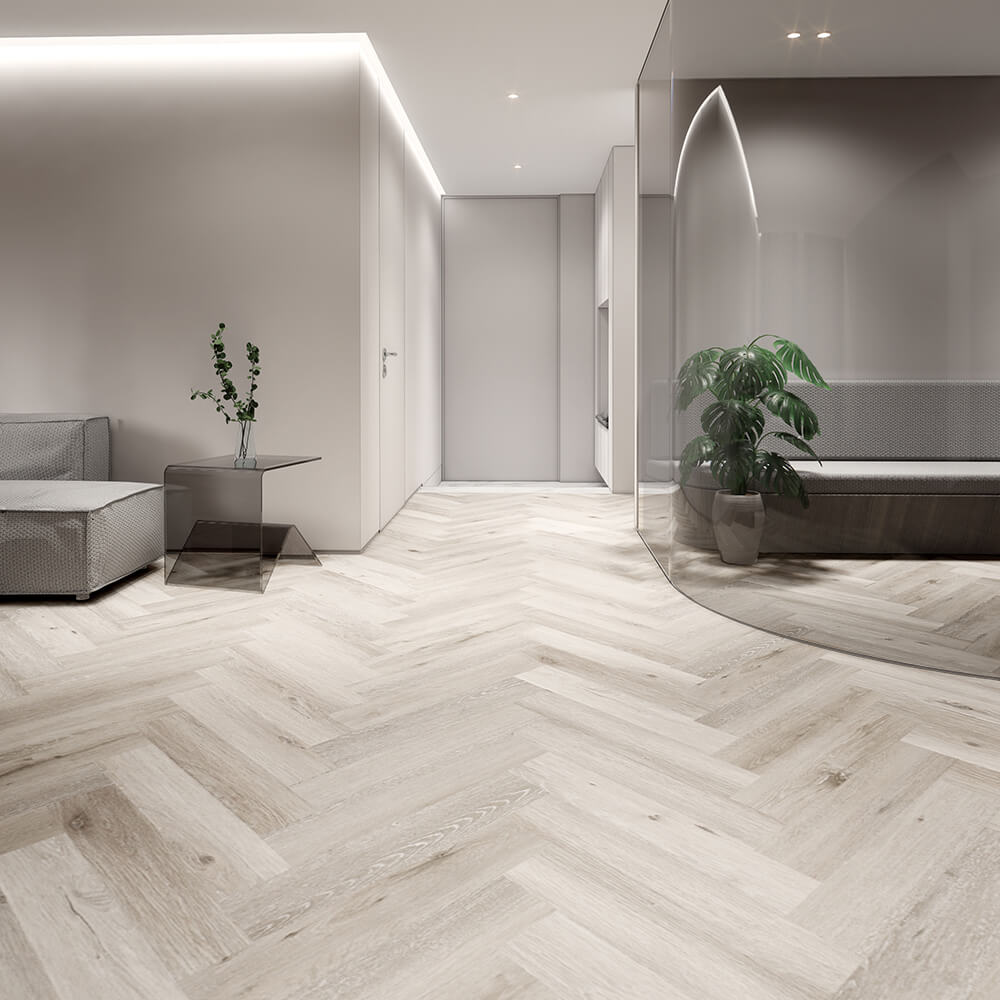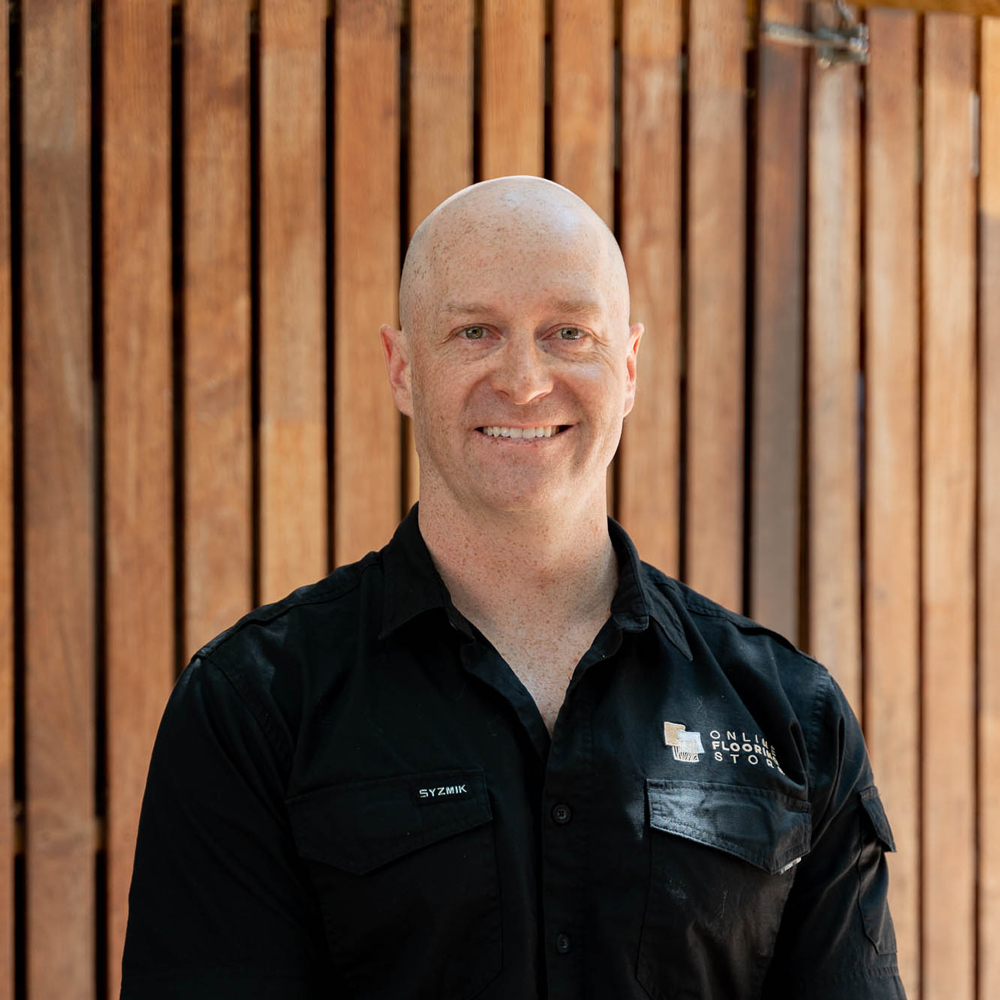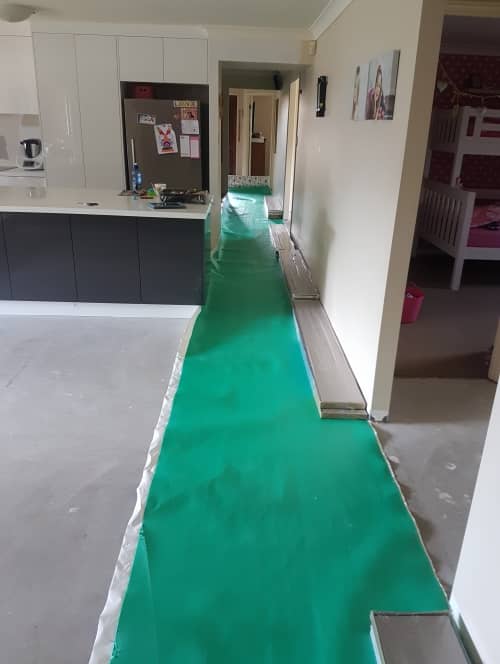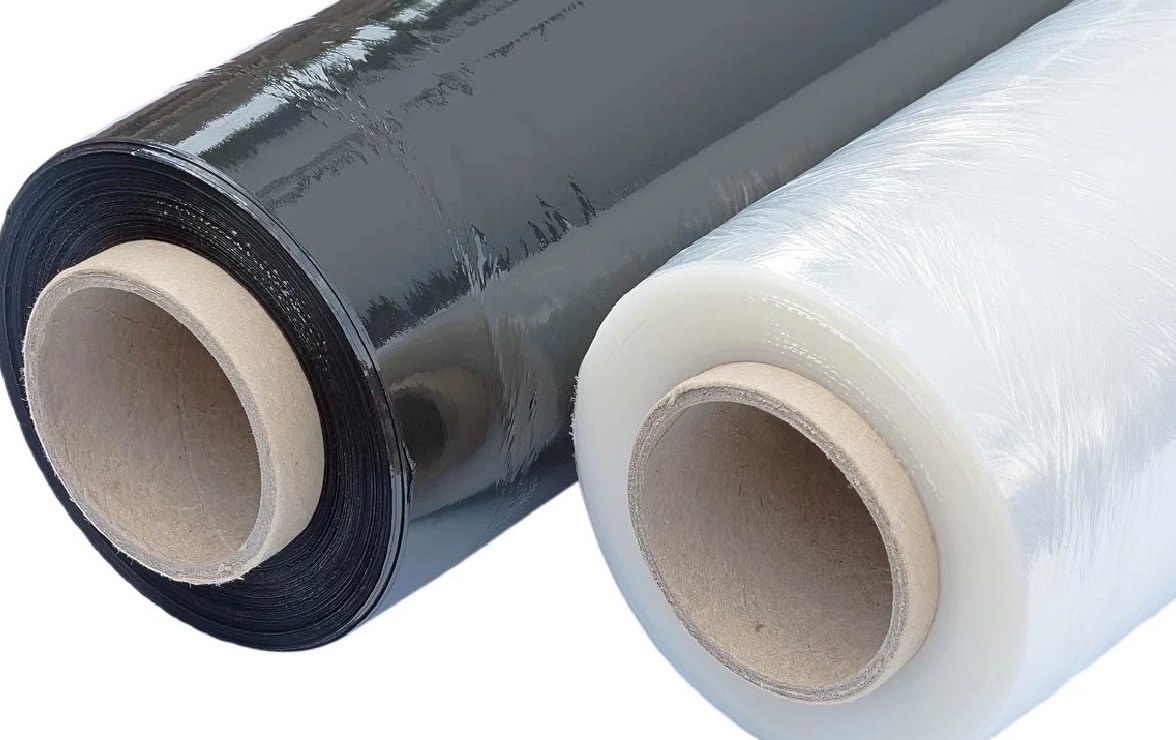If you’ve heard stories of hybrid flooring failures popping up across Australia, chances are you’ve come across the term alkalinity hydrolysis. It sounds technical, and it is, but let me explain it in plain English.
What’s happening is a slow chemical reaction that starts under the floor, not on top. Moisture rising from a concrete slab mixes with the alkaline salts naturally found in the concrete. That vapour creeps into the underside of certain hybrid floors and attacks the polymers that hold the board together. Over time, the joints weaken, the planks start to lift, and everyone points the finger at the product.
Here’s the truth: the flooring itself isn’t the villain; the concrete slab is. And the fix is simple enough that it still amazes me how often it gets skipped. A thirty-dollar roll of builder’s plastic can save thousands of dollars in flooring.
Let’s break down what’s really going on, which hybrids are most at risk, and how to stop alkalinity hydrolysis before it ever starts.
Quick Summary
- The problem: Moisture vapour from new or damp concrete carries alkaline salts that react with polymers inside some hybrid floors.
- The result: The chemical reaction breaks down the board’s core, usually starting at the joins, causing swelling or edge curl.
- High-risk floors: Products with high PVC content and coarser limestone filler are more vulnerable.
- The fix: Lay a 200-micron builder’s plastic sheet (or equivalent vapour barrier) over every concrete subfloor before you click in your hybrid.
- Waterproof ≠ chemical-proof: The planks don’t absorb water, but they can’t stop alkaline vapour sneaking up from beneath.
- Best practice: Choose SPC (Stone Plastic Composite) hybrids over lightweight or aerated-core WPCs.
- Perspective: Every new flooring type has had its teething issues; this is the hybrid’s turn, and the industry’s already on top of it.

Decoline The Herringbone Hybrid Moonriver
What Is Alkalinity Hydrolysis?
Let’s strip the jargon away.
Alkalinity hydrolysis is basically what happens when moisture from a concrete slab mixes with alkaline salts and then finds its way into the back of your hybrid floor. That moisture doesn’t flood your floor like a leak; it travels as vapour, creeping through tiny pores in the slab.
Inside every hybrid board, there’s a blend of stone powder and polymer (plastic) that gives the product its strength. When that alkaline moisture comes into contact with the polymers, it initiates a slow chemical reaction. Over months, sometimes years, the polymers begin to break down.

Expert Insights From Levi Saunders
Online Retail Specialist & Flooring Content Creator
This isn’t just theory; it’s backed by science. A Tampere University study showed that when alkaline moisture comes into contact with PVC (the same polymer found in most hybrid flooring cores), it slowly breaks down the material through alkaline hydrolysis.
The damage always starts where the board is weakest: at the joins. The edges start softening, the locking system loses its bite, and next thing you know, the floor feels spongy or starts to bend up at the edges.
The worst part? It’s not the water itself that’s harming; it’s what’s in the water. The alkalinity is like a slow acid, dissolving the glue inside the product from the bottom up.
I’ve seen jobs where the top of the floor still looked perfect except for the joins, but once we lifted it, the joins underneath had severely deteriorated. You can’t sand it, you can’t repair it; it’s gone. And nine times out of ten, the installer may have skipped the plastic sheet underneath because they thought “the floor’s waterproof.”
That’s why I tell people: hybrid flooring is waterproof, but it’s not invincible.
Which Hybrid Floors Are Most at Risk?
Not every hybrid floor cops with this problem, but some are susceptible.
From what I’ve seen (and what the ATFA’s independent testing confirmed), the risk mostly comes down to what’s inside the core.
Here’s the short version:
- More PVC = more risk. Too much PVC makes the board softer and more reactive to alkaline moisture. This is usually (but not always) evident in products that have a ‘white’ core.
- Coarse limestone filler = more gaps. Larger particles leave tiny voids that let moisture and chemicals move through the board like a maze.
Add those two ingredients together, and you’ve got a board waiting to fall apart on a wet slab.
I’ve always been cautious of “white-core” hybrids or anything that feels unusually light for its thickness. It’s not that every pale core is bad, but most of the early failures I’ve inspected came from that type of formulation.
At Online Flooring Store, we’ve sold brands like Terra Mater ResiPlank hybrids for over five years and haven’t seen a single case of alkalinity hydrolysis. That’s not luck, that’s chemistry. Those products use a denser stone mix and a more stable polymer blend that doesn’t react the same way.
If you’re shopping around, look past the marketing and focus on the manufacturer’s reputation. A few grams less stone might make it easier to lift the box, but it could also be the reason the joints start popping in two years.
How to Prevent It — The $30 Insurance Policy
Here’s the part that still does my head in: People will spend thousands on premium hybrid flooring but won’t bother spending thirty bucks on builder’s plastic, the one thing that could save their floor.
This problem almost always starts at the bottom, so the cure is simple: stop the moisture before it reaches the boards.
A 200-micron builder’s plastic sheet (also called a polyethylene vapour barrier) acts like a chemical shield. It blocks that alkaline moisture from travelling up through the slab and reacting with the flooring.
A few key points:
- Always use it over concrete, old or new. Slabs can release moisture for up to ten years.
- It’s harmless on other subfloors. Works fine over chipboard, tiles or timber.
- Never skip it. Even if your supplier says it’s optional, Clem’s rule: “If it’s on concrete, it gets plastic.”
So, when in doubt, throw the plastic down. It’s the cheapest insurance policy you’ll ever buy for your home.
But I Thought Hybrid Was Waterproof?
You’re right; hybrid flooring is waterproof. But here’s the twist: that doesn’t mean it’s chemical-proof.
- “Waterproof” just means the boards don’t absorb water through the surface. The damage we’re talking about happens from underneath, where chemical vapours sneak up through the slab.
- The flooring isn’t soaking up water like a sponge; the alkaline salts in that moisture are reacting with the core and slowly breaking down the polymers that hold it together.
- Some folks think that’s false advertising. It’s not. Every supplier believed their product was waterproof, because it was, based on the tests available at the time. It took years of real-world installs and independent ATFA testing to reveal this slow chemical process.
Now the fix is clear. The products are improving, installers are wiser, and homeowners can avoid it altogether with proper preparation.
So yes, hybrid is waterproof; It’s just not immune to chemistry.
Lessons From the Past
Every new flooring type cops a few bruises when it first hits the market. Hybrid’s no different.
- Laminate flooring had swelling joins in its early years until new core improvements made many laminates highly water-resistant.
- Vinyl planks are temperature-sensitive. The ‘Loose-Lay’ story is now a thing of the past; every vinyl plank now requires some adhesive.
- Bamboo moved like crazy with humidity due to bad industry standards.
Hybrid is going through its version of that journey now. These alkalinity hydrolysis cases are just part of the learning curve, and they’re already driving better formulas and clearer installation standards.
So don’t write off hybrid because of this. Floors evolve just like everything else. Once the bugs are ironed out, they go from “problem child” to “household favourite.”
Hybrid’s well on its way there; you just have to give it a little respect and a bit of builder’s plastic along the way.
Having said all of this, the failure of hybrid flooring has been far less than that of any flooring category so far. However, some retailers are reverting to other products, but are only able to do so because these products have been through their teething stage.
SPC vs WPC – Choosing the Right Core
If you’ve been shopping for hybrid flooring, you’ve probably seen two main types: SPC and WPC, or other types of aerated core hybrids such as IPC and EPC.
SPC (Stone Plastic Composite)
- Denser, heavier, and more stable under heat.
- Finer stone particles bound in polymer resin.
- Feels firm underfoot and resists chemical attack better because it has less PVC and fewer voids.
WPC (Wood or Aerated Core)
- Lighter, spongier feel.
- Higher PVC and air pockets = softer and more flexible, but also more vulnerable to heat and alkalinity.
- Honeycombed joins allow moisture to spread quickly once it gets in.
When I was working at Embleton, the early WPC hybrids were nightmares; constant claims and warped floors. Working at Signature, I had a very different experience with SPC products, as they were more refined and rock-solid.
That’s why at Online Flooring Store, we’ve stuck with SPCs from day one. “It’s a hard no from me on WPC — even with my industry experience.”
Some suppliers are experimenting with “SPC sandwich” designs; SPC layers top and bottom with a lighter core in the middle, but they’re still unproven and more expensive.
If you want flooring that can handle Australian heat and humidity, stick with SPC hybrids from reputable suppliers.
FAQ’s
Alkalinity hydrolysis is a slow chemical reaction that happens when moisture from a concrete slab mixes with alkaline salts and rises into the underside of hybrid flooring. The vapour attacks the polymers inside the core of the floorboards, slowly breaking them down from beneath. The result? Soft joins, lifting planks, and swelling edges; even though the top of the floor still looks perfect.
It starts with moisture. Concrete naturally gives off vapour as it cures or absorbs humidity from the ground. When that vapour carries alkaline salts, it reacts with the PVC (plastic) inside some hybrid floors. Over time, that reaction weakens the board’s core, especially at the locking system. It’s not poor-quality flooring; it’s a chemical reaction between the slab and the polymer.
The fix is cheap and easy: use a 200-micron builder’s plastic sheet (or equivalent vapour barrier) before laying hybrid flooring over any concrete slab.
That simple layer blocks alkaline moisture from reaching the boards. It’s harmless to use over timber, tiles, or chipboard too, so there’s never a reason to skip it.
As I always say: “If it’s on concrete, it gets plastic.”
Hybrid flooring is waterproof, but it’s not chemical-proof.
“Waterproof” just means it won’t absorb surface spills. The problem here happens underneath, when alkaline vapour sneaks through the concrete. That vapour doesn’t soak the boards; it reacts with the core, slowly breaking down the polymers that hold everything together. So, waterproof? Yes. Invincible? No.
The hybrids most vulnerable to alkalinity hydrolysis are those with:
- High PVC content (softer, whiter cores)
- Coarse limestone filler that leaves tiny gaps for moisture to move through. Lightweight, “white-core” hybrids or early WPC (Wood Plastic Composite) products are more prone to failure. SPC (Stone Plastic Composite) hybrids, on the other hand, are denser, heavier, and much more stable under Australian conditions.
SPC (Stone Plastic Composite) hybrids use fine stone powder and a tighter polymer blend. They’re dense, solid underfoot, and more resistant to heat and chemical attack.
WPC (Wood Plastic Composite) hybrids feel lighter and spongier, but that softness comes with more air pockets and higher PVC, meaning more vulnerability to moisture and alkalinity.
If you ask me, “It’s a hard no from me on WPC; even with my industry experience.”
Unfortunately, no. Once the polymer in the core breaks down, the board loses its strength permanently. You can’t sand it or glue it back. The only real fix is prevention; use a vapour barrier from the start.
A surprising amount of time, up to 10 years, depending on conditions. Even older slabs can absorb and release moisture through seasonal changes. That’s why the vapour barrier rule isn’t just for new builds; it applies to every slab, every time.
Not at all. Quality matters. Brands that use denser stone mixes and stable polymer formulations like Terra Mater ResiPlank hybrids, have shown excellent resistance to alkalinity hydrolysis. The failures we see usually trace back to budget products or missing moisture protection underneath.
Absolutely, just install it properly. Every flooring type has had its “teething stage.” Laminate swelled, bamboo warped, vinyl needed glue… hybrid’s turn was alkalinity hydrolysis.
The good news is the industry’s already learned from it. Modern SPC hybrids, laid over builder’s plastic, are one of the most durable and versatile flooring options you can buy.




